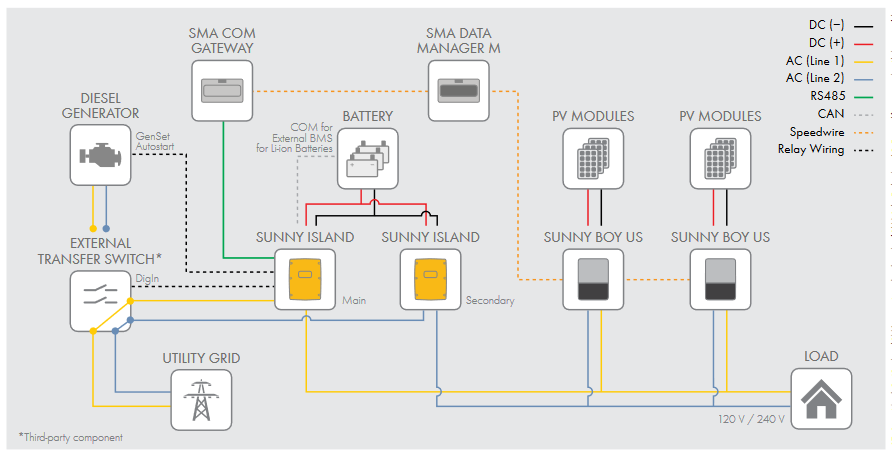The problem -- you have grid-tied (or gridutility-following)interactive inverters
GridUtility-tieinteractive inverters (also known as grid-tie or grid following) use phase-locked loop (PLL) control to match the frequency and phase of their output signal to what they detect on the grid. In doing this they also affect the grid, but these changes are barely perceptible (ripples in an ocean). But if the grid is absent, the changes that each inverter implements would have a greater effect (ripples in a teacup), causing cascading fluctuations on the inverter network, which feeds back to the input of each inverter. As the changes amplify, the PLL will become unstable and the inverter will shut down. The UL 1741 limits* are programmed to shut the inverters down before they reach this technical limit, but either way, if the input ac signal starts fluctuating too quickly, the inverters will shut down.
Solution one: off-gridStandalone inverters with communication
OffStandalone or off-grid inverters (that you'd use for a camper, boat, or remote cabin) develop and sustain their own 60 Hz signal. There's a chance you could install a single off-gridstandalone inverter in your system (perhaps at the ???? location, drawing off the battery bank), and the gridutility-tiedinteractive inverters would be fooled into following it.
- The signal probably won't be "stiff" enough. Standard off-gridstandalone inverters aren't designed to work in tandem with gridutility-tiedinteractive inverters, so the signal they provide is unlikely to be stiff enough to "fool" them.
- GridUtility-tiedinteractive inverters are current sources and could cause runaway voltage without sufficient load. Standard gridutility-tiedinteractive inverters are designed to push a steady current out by raising their output voltage. When connected to the grid, there's a huge sink for this current to go to, so they don't have to raise the voltage much at all. But in an off-grid situation, if they run out of load (batteries are charged and nothing is using power), they might increase the voltage until something breaks. For many inverters, anti-islanding protection is the only way to prevent this -- they can't be online without the grid as a sink, so this problem won't occur. Others will stop producing all power if the voltage goes too high (as a backup to anti-islanding protection), while others have the ability to limit the output voltage and continue producing (less) power.
The Sunny Island inverter from SMA is an example of an off-grida standalone inverter that can do this with other SMA inverters. You can see the communication interface in the diagram below:
Solution two: an ac-coupled system with a grid-forming multimode inverter
These inverters are called grid forming because they create a stiff enough signal to provide support for grid following inverters. Multimode refers to their ability to be utility-interactive when connected to the grid, and standalone otherwise.


